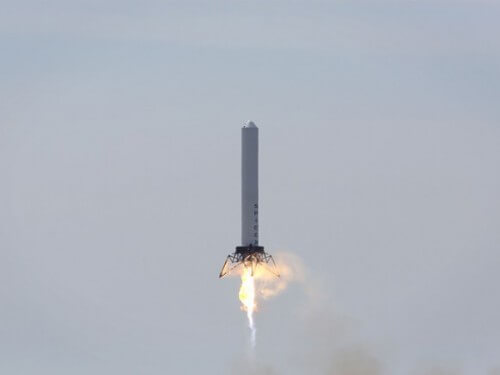The purpose of these experiments is to develop a first stage that lands vertically and can be reused instead of dropping it into the ocean as is done today, thus reducing the cost of space launches

Last week SpaceX conducted a test launch of a Grasshopper rocket - a rocket that takes off vertically like any rocket, but unlike other rockets it also lands on its feet.
In the test, on March 7, the missile took off to a height of 80.1 meters, hovered for 34 seconds and landed safely - and with greater precision than ever before. The purpose of the grasshopper is to ultimately enable the development of a reusable first stage for SpaceX's Falcon 9 rocket, which can land safely instead of falling into the ocean without being able to take off again.
SpaceX CEO Elon Musk unveiled the video over the weekend during the South and Southwest Festival in Austin, Texas, and called the flight Johnny Cash's levitation smash, with the song accompanying the video being the famous country singer's "Rings of Fire." A cowboy doll was attached to the side of the rocket.
The test was conducted at the SpaceX rocket facility in McGregor, Texas. This is the grasshopper's fourth test flight, with each flight reaching a higher altitude. In September a missile of this model was launched to a height of 2.5 meters, in November - 5.4 meters and in December a more advanced model was already launched to a height of 40 meters.
The Grasshopper is 10 stories high, and consists of a Falcon 9 fuel tank stage, a Merlin 1D engine, four steel and aluminum landing legs and a device that relaxes these legs during landing, as well as a steel supporting structure.
In the end, the ability to reuse a very important component of the launch, may make the launches into space cheaper, the price of which today is tens of thousands of dollars per kg for low orbit.
For the news in Universe Today
https://www.youtube.com/watch?v=WFAfF1aTjNI

9 תגובות
How is space tourism developing? Amazing.
I am already impatiently waiting for the moment when I will explore space, from space.
You are confusing different experiments, at the end of the news I mentioned that this was the fourth experiment and each experiment was higher than the previous ones
Good morning.. It turns out that this was posted exactly three months ago.. I read it on this excellent blog:
http://nicecriticalmass.blogspot.co.il/2012/12/SpacexGrasshopper.html
On the one hand, parachutes can be used to slow down the missile in its return to save fuel
In the landing that will only be completed by means of rocket propulsion, on the other hand maybe much simpler
use onyx parachutes - a development of DARPA. This is a parachute system
A GPS guide that already today can land 1100 kg with incredible accuracy from a distance
of about 50 kilometers.
Isn't it enough that swarms of grasshoppers have recently invaded our districts, now also mechanical grasshoppers that land vertically?
The challenges for space flight are so different that it is a curiosity. Landing a robot on the moon.
On a journey to Mars, how will they take water for a year and a half, and what will they do if there is a problem on the way. It is also quite clear that propulsion in space is different from detachment on Earth, rocket propulsion is outdated. Outside of Earth, projectile propulsion according to Newton's first law is obsolete. Nuclear propulsion is a little less obsolete. Not fuel but engine.
How will bone degeneration be avoided during a year and a half. Should we prepare an infrastructure for life on Mars so that the midpoint of the journey will be safer? How will they produce oxygen during a year and a half. more and more. A trip to the moon seems a curiosity.
It doesn't make the most sense to me that it would work, but I'm not the expert...
The costs of the extra fuel required to land and increasing the volume of the fuel tank for it and in addition it doesn't seem to have any stabilizers - meaning a slight deviation from the trajectory and the launch angle (even strong winds) would just make this whole landing mechanism irrelevant in my opinion... but again, probably the experts And the engineers who built it took everything into consideration
Very cool, but I've already seen YouTube videos about two years ago of similar missiles landing vertically, the concept is not new.
What a championship, amazing.